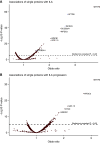The Proteomic Profile of Interstitial Lung Abnormalities
- PMID: 35438610
- PMCID: PMC9890263
- DOI: 10.1164/rccm.202110-2296OC
The Proteomic Profile of Interstitial Lung Abnormalities
Abstract
Rationale: Knowledge on biomarkers of interstitial lung disease is incomplete. Interstitial lung abnormalities (ILAs) are radiologic changes that may present in its early stages. Objectives: To uncover blood proteins associated with ILAs using large-scale proteomics methods. Methods: Data from two prospective cohort studies, the AGES-Reykjavik (Age, Gene/Environment Susceptibility-Reykjavik) study (N = 5,259) for biomarker discovery and the COPDGene (Genetic Epidemiology of COPD) study (N = 4,899) for replication, were used. Blood proteins were measured using DNA aptamers, targeting more than 4,700 protein analytes. The association of proteins with ILAs and ILA progression was assessed with regression modeling, as were associations with genetic risk factors. Adaptive Least Absolute Shrinkage and Selection Operator models were applied to bootstrap data samples to discover sets of proteins predictive of ILAs and their progression. Measurements and Main Results: Of 287 associations, SFTPB (surfactant protein B) (odds ratio [OR], 3.71 [95% confidence interval (CI), 3.20-4.30]; P = 4.28 × 10-67), SCGB3A1 (Secretoglobin family 3A member 1) (OR, 2.43 [95% CI, 2.13-2.77]; P = 8.01 × 10-40), and WFDC2 (WAP four-disulfide core domain protein 2) (OR, 2.42 [95% CI, 2.11-2.78]; P = 4.01 × 10-36) were most significantly associated with ILA in AGES-Reykjavik and were replicated in COPDGene. In AGES-Reykjavik, concentrations of SFTPB were associated with the rs35705950 MUC5B (mucin 5B) promoter polymorphism, and SFTPB and WFDC2 had the strongest associations with ILA progression. Multivariate models of ILAs in AGES-Reykjavik, ILAs in COPDGene, and ILA progression in AGES-Reykjavik had validated areas under the receiver operating characteristic curve of 0.880, 0.826, and 0.824, respectively. Conclusions: Novel, replicated associations of ILA, its progression, and genetic risk factors with numerous blood proteins are demonstrated as well as machine-learning-based models with favorable predictive potential. Several proteins are revealed as potential markers of early fibrotic lung disease.
Keywords: biomarkers; idiopathic pulmonary fibrosis; interstitial lung abnormalities; interstitial lung disease; proteomics.
Figures



Comment in
-
Biomarkers for Interstitial Lung Abnormalities: A Stepping-stone Toward Idiopathic Pulmonary Fibrosis Prevention?Am J Respir Crit Care Med. 2022 Aug 1;206(3):244-246. doi: 10.1164/rccm.202205-0839ED. Am J Respir Crit Care Med. 2022. PMID: 35580066 Free PMC article. No abstract available.
References
Publication types
MeSH terms
Grants and funding
- R01 HL113264/HL/NHLBI NIH HHS/United States
- R01 HL137995/HL/NHLBI NIH HHS/United States
- U01 HL089897/HL/NHLBI NIH HHS/United States
- R01CA203636/NH/NIH HHS/United States
- R01 HL137927/NH/NIH HHS/United States
- P50 HL084948/HL/NHLBI NIH HHS/United States
- R01 HL137927/HL/NHLBI NIH HHS/United States
- K08 HL136928/HL/NHLBI NIH HHS/United States
- HHSN27120120022C/NH/NIH HHS/United States
- R01 133135/NH/NIH HHS/United States
- R01 HL137995/NH/NIH HHS/United States
- N01-AG-1-2100/NH/NIH HHS/United States
- K08 HL136928/NH/NIH HHS/United States
- 5U01CA209414-03/NH/NIH HHS/United States
- R01 HL111024/NH/NIH HHS/United States
- R01 HL152735/NH/NIH HHS/United States
- P01 HL114501/NH/NIH HHS/United States
- P50HL084948/HL/NHLBI NIH HHS/United States
- R01 135142/NH/NIH HHS/United States
- R01 137927/NH/NIH HHS/United States
- R01 HL135142/NH/NIH HHS/United States
- R21 HL129917/HL/NHLBI NIH HHS/United States
- R01 HL130974/HL/NHLBI NIH HHS/United States
- R21HL129917/HL/NHLBI NIH HHS/United States
- K08 HL140087/NH/NIH HHS/United States
- R01 HL152735/HL/NHLBI NIH HHS/United States
- R01 HL113264/NH/NIH HHS/United States
- K08 HL140087/HL/NHLBI NIH HHS/United States
- R01 HL111024/HL/NHLBI NIH HHS/United States
- U01 HL089856/HL/NHLBI NIH HHS/United States
- R01 HL129937/HL/NHLBI NIH HHS/United States
- R01 HL135142/HL/NHLBI NIH HHS/United States
- U01 HL089856/NH/NIH HHS/United States
- R01 CA203636/CA/NCI NIH HHS/United States
- U01 CA209414/CA/NCI NIH HHS/United States
- R01 HL130974/NH/NIH HHS/United States
- P01 HL114501/HL/NHLBI NIH HHS/United States
LinkOut - more resources
Full Text Sources
Medical
Research Materials
Miscellaneous

